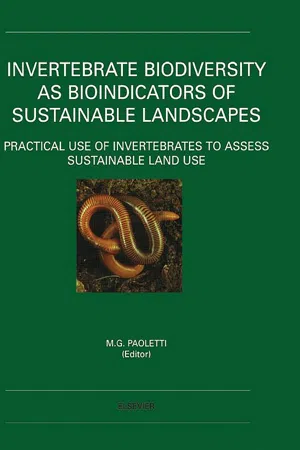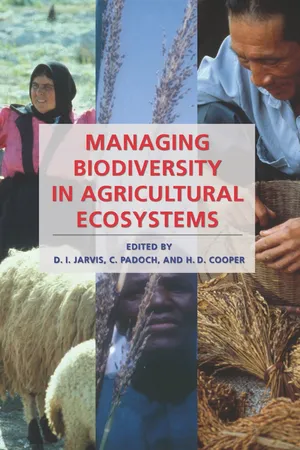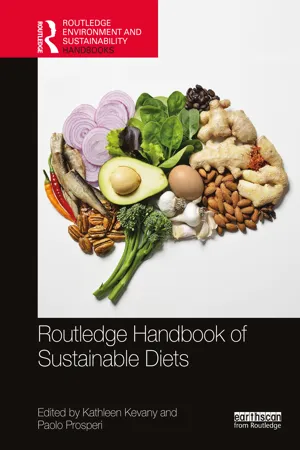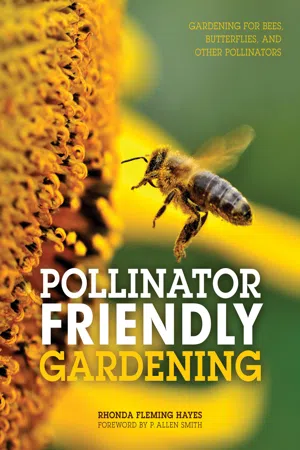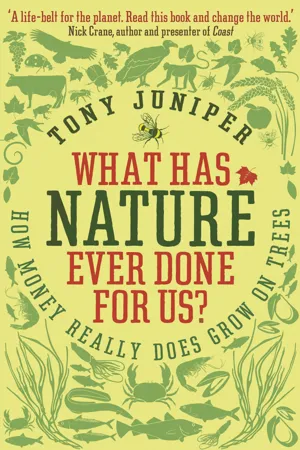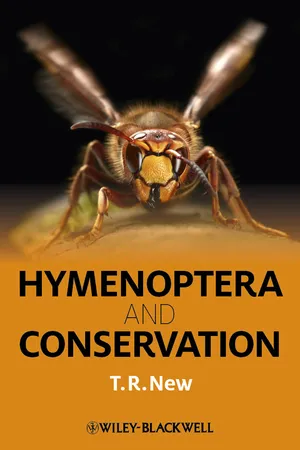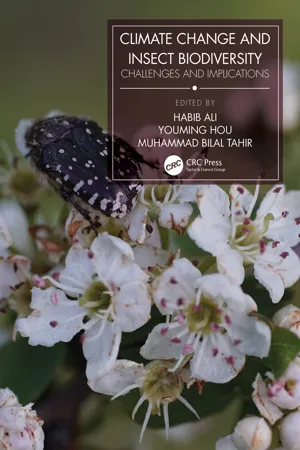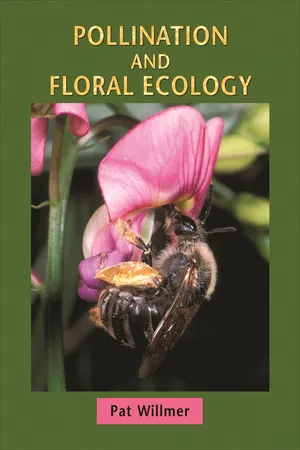Geography
Pollinators
Pollinators are animals or insects that transfer pollen from the male to the female parts of flowers, enabling the plants to reproduce. They play a crucial role in the pollination process, which is essential for the production of fruits, seeds, and new plants. Examples of pollinators include bees, butterflies, birds, and bats.
Written by Perlego with AI-assistance
Related key terms
9 Key excerpts on "Pollinators"
- eBook - ePub
Invertebrate Biodiversity as Bioindicators of Sustainable Landscapes
Practical Use of Invertebrates to Assess Sustainable Land Use
- Maurizio G. Paoletti(Author)
- 2012(Publication Date)
- Elsevier Science(Publisher)
He points to a vicious cycle of reduced vegetation for Pollinators’ resources, reduced pollination in the vegetation, the demise of the plant’s reproductive success and reductions in seed and fruit set, resulting in the failure of revegetation with the equivalent level of biodiversity as would have otherwise existed. This cycle applies to all parts of the world because pollination by animals is an integral part of almost all terrestrial ecosystems (see also Kevan and Collins, 1974 ; Ambrose and Kevan, 1990 ; Haack, 1994). As some recent books and reviews on conservation of insects and their habitats give short shrift to Pollinators, readers should consult the more specific treatises (Buchmann and Nabhan, 1996 ; Matheson et al., 1996). The fact that Pollinators and landscape ecology are so interrelated, makes pollinator assemblages bioindicators of land use. Specialized works on bees (Roubik, 1989 ; Westrich, 1990) and on butterflies and moths, for example, indicate the species associated with particular habitats, or landscape elements, as exemplified by bees of tropical Asia (A ppanah and Kevan, 1995). Although, the actual species differ between continents, latitudes, altitudes, and biomes, some general remarks about Pollinators as bioindicators can be made. In urban environments, many people value flower visiting insects, and various publications are available for encouraging butterflies in gardens. In Europe, several studies have been made on bees in cities (Haeseler, 1982 ; Jacob-Remacle, 1984 ; Kratochwil and Klatt, 1989 ; Torres et al., 1989; Sauer, 1996) and other highly anthropogenic environoments (Haeseler, 1972) studied the effects of artificial domiciles in encouraging urban populations of bumblebees in Liège, Belgium - eBook - ePub
- D. I. Jarvis, Christine Padoch, H. D. Cooper(Authors)
- 2007(Publication Date)
- Columbia University Press(Publisher)
Pollinator ServicesP. G. KEVAN AND V. A. WOJCIKHerbivores, predators, parasitoids, parasites, and pathogens are understood ecologically as crucial to sustaining ecosystems and their diversity. Nevertheless, just as important are the mutualistic relationships. Pollination is the hub of a multispoke productivity wheel that has all consumers—humans, livestock, and wildlife—at the rim (figure 8.1 ). Ecological interactions and complexity now are within the domain of conservation and sustainability. The biodiversity of the world’s dominant flora (flowering plants) and dominant fauna (insects) are so intimately and coevolutionarily enmeshed through pollination that the erosion of the processes has serious environmental consequences. Indeed, pollination is now regarded as a jeopardized ecosystem service that warrants attention in all terrestrial environments, from intensive agriculture to wilderness (Buchmann and Nabhan 1996). Moreover, nonpollinating flower visitors in the web of life provide benefits, and sometimes problems, that are essential to other aspects of ecosystemic function.Although pollination has been studied for more than 200 years, it is often overlooked and misunderstood. Therefore the roles of Pollinators and flowers and the problems associated with declining biodiversity and the need for conservation deserve explanation. The importance of Pollinators and other anthophiles (flower visitors) extends beyond ecosystem sustainability, plant reproduction, crop productivity, and pest management into aesthetic and ethical aspects of the quality of human life. Finally, Pollinators and anthophiles may also be sensitive bioindicators of ecosystemic health.FIGURE 8.1 . Pollination systems are at the center of ecosystems and ecosystem functions. Both direct and indirect interactions tie the entire biosphere to pollinator services in some manner.Pollination, Pollinators, and AnthophilesPollination is simply the transfer of pollen from the anther to the stigma. After the production of reproductive structures by the plant, pollination is the next step in reproduction. Abiotic pollination occurs by wind, water, or gravity. Biotic pollination is effected by animals. There is a large and specialized vocabulary concerned with pollination and plant breeding systems, which need not be detailed in this review. For crops, Roubik (1995) and Free (1993) are encyclopedic. - eBook - ePub
- Kathleen Kevany, Paolo Prosperi, Kathleen Kevany, Paolo Prosperi(Authors)
- 2022(Publication Date)
- Routledge(Publisher)
Eilers et al., 2011 ).Box 8.4 Biotic pollination defined. Source: The work of the authorsBiotic pollination: Plants can only produce seeds (and hence, fruit) if pollination occurs. Pollination can happen abiotically by wind or water, or through animal pollination (including insects) referred to as biotic pollination.Pollinators are a diverse group of animals including bees, beetles, birds, butterflies, moths, wasps, flies, bats, and other small mammals. While there are diverse Pollinators (Figure 8.2 ), bees are responsible for the majority of the biotic pollination of crops used by people for food, fuel, fibre, medicine, and cultural practices (IPBES, 2016 ).Figure 8.2 The first and third images are bees (order Hymenoptera), the second and last image are flies (order Diptera) that are sometimes called “bee mimics,” all of which can provide important pollination services. These insects are all black and yellow, however, pollinating insects come in many colours, shapes, and sizes.Source: Photos by co-author Jennifer Marshman.The common slogan of “save the bees” is often accompanied by images of honey bees on flowers or in their constructed hives. The western honey bee (Apis mellifera)1 dominates depictions of the pollinator, perpetuating industry-based priorities and market interests (Colla & MacIvor, 2017 ; Marshman & Knezevic, 2021 ; Reilly et al., 2020 ). With an estimated 30,000–100,000 bees per colony, commercial beekeepers can readily transport colonies to areas where crops require pollination. Rarely do images of honey bees depict the reality of the manner or the magnitude by which many commercial bees are managed and deployed for their pollination services (i.e. hundreds of hives stacked on transport trucks for shipping cross-country). Instead, depictions of bees tend to use imagery of chubby bees happily flitting from flower to flower, leveraging the “pollinator idyll” to promote the “save the bees” narrative (Marshman & Knezevic, 2021 - eBook - ePub
Pollinator Friendly Gardening
Gardening for Bees, Butterflies, and Other Pollinators
- Rhonda Fleming Hayes(Author)
- 2016(Publication Date)
- Voyageur Press(Publisher)
CHAPTER 1UNDERSTANDING Pollinators
Bees need flowers for the nectar and pollen they provide in return for pollination services.WHAT IS POLLINATION?
Imagine a summer without blueberry pie, without icy, cold watermelon. Not into sweets that much, you say? Picture your tortilla chips minus the salsa and guacamole. If that doesn’t worry you, this one will: how would you get along without that mid-afternoon chocolate bar or your morning coffee?Without Pollinators, these delicious treats would disappear. Oh, you’d still have corn and wheat, although that might get a bit dull. Pollinators are responsible for every third bite of food you take, but more importantly the colorful and healthy fruits and vegetables that perk up your dinner plate. But it goes deeper than that. Two-thirds of the entire world’s plant species depend upon animal pollination. Plants that feed insects that feed birds and frogs that feed the snakes and owls and on up the food chain…you get the idea. Without the vital services of Pollinators, the whole grand scheme falls apart.Much of this tasty lunch was made possible by Pollinators.It could be said that insects run the world. Yet many people still don’t realize the critical role pollination plays in maintaining human sustenance and a healthy, diverse ecosystem. Some possess a vague memory from biology class, a diagram of flower parts and something about bees. Mention pollen and their first thoughts go to the invisible irritants that float in the air, stuffing up their noses and making their eyes itch and water. Pollen is that pesky yellow dust on their cars when they park outside. Pollen is the orange stain on their shirt when they brush up against lilies in a hotel lobby bouquet.Far from a nuisance, pollen is the magic dust that makes everything possible. Gardeners marvel at tiny seeds and how they produce such a beautiful variety of plants. Pollen is fascinating, too. It comes in many shades besides yellow—pale gray, light green, brick red, steely blue, black, and many gradations in between. Beekeepers can often learn where their bees forage by noting the pollen color they bring back. You’d be surprised at some—white snowdrops, for example, have red pollen, and red poppies have black. - eBook - ePub
What Has Nature Ever Done For Us?
How Money Really Does Grow On Trees
- Tony Juniper(Author)
- 2013(Publication Date)
- Profile Books(Publisher)
The many, many thousands of pollination relationships that have been established are a key factor in shaping the character of natural systems. Without Pollinators, most ecosystems would not function as they do now, and that would lead to a reduction in diversity and a diminishing of the services that natural systems provide for us. Indeed, some ecologists now believe that a breakdown in pollination relationships has been an underestimated cause of past extinctions, as reduced genetic diversity within a plant species can reduce its ability to adapt to changing conditions or to develop resistance to diseases.While these ecosystem-sustaining aspects of pollination are important for the functioning of the human economy because of the services provided by ecosystems, such as flood protection and carbon storage, of most practical and immediate importance for us is the contribution that pollinating animals make to agriculture.When the wild bees are absent
As became apparent with the arrival of European-style farming in New Zealand, pollination is vital for food production, both for the plant crops we eat and the productivity of the pastures upon which meat and dairy-producing livestock is grazed. But it is not just a problem of the past. Across the world, there are farming communities who are aware of the practical value of Pollinators – because of their absence. One example is the almond-growing region of the Central Valley of California.This is one of the most intensively farmed regions in the United States; in an area of more than a quarter-million hectares, some four-fifths of the world’s almond crop is produced. The conditions are ideal. It is mild, there are cool wet winters, the soils are right and there is plenty of sunshine when the almonds are growing. So good is it that the land is cranked to the maximum to boost both yields and profits.Robin Dean is an adviser on strategies to increase bee populations, and with his wife runs a successful enterprise called the Red Beehive Company, which helps clients ensure effective pollination. He explained to me that the exclusive farming of almonds in the Central Valley had brought the land close to crisis: ‘The soil is being hammered, water is under stress, there are issues with soil salinisation from irrigation, and then all the issues with crop protection chemicals. Almonds are harvested mechanically with a tree shaker that causes the nuts to drop to the floor. The nuts are then pushed into rows, are left to dry and then they are vacuumed up. With this system you don’t want anything growing on the ground under the trees. The entire area is completely barren except for almond trees and it is like that for miles.’ One consequence of this, says Dean, is that ‘there are no natural Pollinators remaining in the landscape’. And this poses something of a challenge. - eBook - ePub
Urban Ecology
Its Nature and Challenges
- Pedro Barbosa, Pedro Barbosa(Authors)
- 2020(Publication Date)
- CAB International(Publisher)
6 Protecting Pollinators in the Urban EnvironmentLisa J. Kuder* , Lindsay Miller Barranco and Dennis van EngelsdorpDepartment of Entomology, University of Maryland, College Park, Maryland* Corresponding author: [email protected]IntroductionWith urban land area expected to triple from 2000 to 2030 (Seto et al., 2012), more species will come into contact with metropolitan environments. Such areas are traditionally viewed as biological deserts with marginal conservation value, as they are associated with habitat degradation and species loss (Hall et al., 2017; McKinney, 2008). However, the rapid expansion of urbanization and the global concern about biodiversity loss have led to greater awareness and interest in urban ecology. Urban planners are starting to rethink the role of cities by incorporating ecological function and conservation into design and renovation projects. Urban areas are thus increasingly recognized as having potential to protect insect diversity and their ecosystem services, particularly pollination (Baldock et al., 2015; New, 2015).Pollinators comprise a variety of organisms, ranging from bats to birds and a host of insects including beetles, butterflies, flies, moths and, of course, bees. Managed and wild bees are the most efficient Pollinators thanks to their specialized pollen collecting tools and foraging behaviours (Wilson-Rich, 2014). Approximately 75% of agricultural food crops (Klein et al., 2007; Aizen et al., 2009) and 89% of wild flowering plants, at least to some extent, rely on bee pollination (Ollerton et al., 2011). From an economic perspective, pollination of global agricultural crops is valued at an estimated $US351 billion annually (Lautenbach et al - eBook - ePub
- T. R. New(Author)
- 2012(Publication Date)
- Wiley-Blackwell(Publisher)
The threats to pollinating insects, of course, parallel those to many others, and their detection and management is the core of practical conservation and the foundation of much conservation planning. The threats range from those that are tangible and obvious, and so amenable to management, to those for which the influences and rate of impacts are highly uncertain. Loss or change to habitats and resource supply and interactions with invasive species are the most commonly cited and clearly definable threats to Pollinators of agricultural interest, and are dominant themes both in the foregoing chapters and those to come as of almost universal importance in conservation.In contrast, the impacts of projected climate changes are difficult to assess, as these will affect crop distributions, in addition to those of the pollinating agents. Impacts to many Hymenoptera may be expected to mirror those reported for some better-known insects (predominantly butterflies and dragonflies) in linking climate change with species’ range changes, synchrony with critical resources and changing community composition and interactions as other species invade. Impacts on vegetation may lead directly to changed capability of Pollinators to thrive. Changed distribution patterns of butterflies and other insects are already evident in Europe, for example, and the array of novel competitive interactions that may arise from any similar movements of bees remains highly uncertain. Thus, in the past, bumblebees have been amongst the predominant groups of flower visitors (presumed as Pollinators) in higher latitudes of the northern hemisphere, with other groups of Pollinators increasing in relative importance further south. Whether those bumblebees may be disadvantaged by spread northward of additional species is unknown, but that possibility must be included in conservation considerations. Studies in the Arctic region may be particularly informative because in this extreme environment with relatively few resident species, warming could lead to loss of entire cold-adapted communities. - eBook - ePub
Climate Change and Insect Biodiversity
Challenges and Implications
- Habib Ali, Youming Hou, Muhammad Bilal Tahir, Habib Ali, Youming Hou, Muhammad Bilal Tahir(Authors)
- 2023(Publication Date)
- CRC Press(Publisher)
(2013) used historical data sets to quantify the impact of global changes over the past 120 years on the interplay between plants and Pollinators in the temperate forest understory of Illinois, United States. The study found that 50% of bee Pollinators experienced changes in their interactions, network structure, and function, which can be attributed to phenological mismatches between plants and bees, nonrandom bee species extinction, and changes in the spatial coexistence of existing species. At the same time, the quantity and quality of pollination services have decreased over time, and the adaptability of pollination network structures to future changes is gradually decreasing. Suppose species have different abilities to track climate change through migration and diffusion. In that case, new species combinations may form, and the disintegration and reorganization interaction network may change species richness, distribution, and extinction probability under climate change, increasing the risk of species extinction (Gilman et al., 2010). In addition to some specialized pollination relationships, many plants form generalized connections with pollinating insects; that is, a plant can be accessed by different pollinating insects at different times and locations and can achieve the same pollination efficiency. Some studies have shown that as altitude increases, the decrease in species will lead to a decrease in the abundance of pollinating insects. In high-altitude regions, pollinating insects have a more generalized selection of plants, with a greater width of their nutrient niche (Lara Romero et al., 2019). Research on the structure of pollination networks has shown that many species can sustain their survival by rapidly responding to environmental changes - eBook - ePub
- Patricia Willmer(Author)
- 2011(Publication Date)
- Princeton University Press(Publisher)
However, perhaps the best indicators of the problem come from documented parallel declines in Pollinators and in the plants that they pollinate, and this evidence was provided by Biesmeijer et al. (2006) for bees, hoverflies, and entomophilous plants across the United Kingdom and the Netherlands, comparing pre-and post-1980 records. Plate 39 shows the effect for British bees. These authors found the most marked changes in flower specialists and habitat specialists, in univoltine species, and in nonmigrants, with outcrossing plants showing linked declines. Based on these kinds of findings, major initiatives are being set up to record and conserve native bees, especially in Europe and North America. Banaszak (1992) provided an early summary of the necessary measures.2. Particular Threats to Pollinators
Habitat Degradation and Destruction
Since pollination involves more or less specific interactions, any habitat effects that alter the distribution or abundance of a particular species pose potential risks to the associated partners; and shifts in distribution of one plant or animal in response to habitat change, even without population decline, risk uncoupling relationships whether these be the rare obligate associations or more generalized interactions. Most commonly plants are able to “move” only slowly as their habitats change, so they may be left behind by more mobile animals.Species that lose their Pollinators may persist for some time, perhaps with some asexual reproduction, but are in an evolutionary sense at a dead end. Thus habitat destruction can leave an extinction debt that only becomes apparent years or decades later. While obligate mutualisms with reliance on a single pollinator are very rare and the risks of overdependence are obvious, they do involve some key species, especially figs (chapter 26), whose loss can have a disproportionately large influence on plant and animal community structures.
Index pages curate the most relevant extracts from our library of academic textbooks. They’ve been created using an in-house natural language model (NLM), each adding context and meaning to key research topics.
